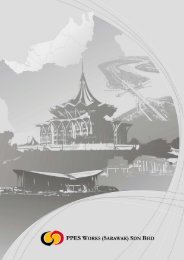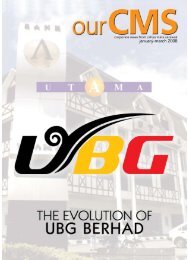Notes to the Financial Statements - Cahaya Mata Sarawak Bhd
Notes to the Financial Statements - Cahaya Mata Sarawak Bhd
Notes to the Financial Statements - Cahaya Mata Sarawak Bhd
You also want an ePaper? Increase the reach of your titles
YUMPU automatically turns print PDFs into web optimized ePapers that Google loves.
102<br />
<strong>Notes</strong> <strong>to</strong> <strong>the</strong> <strong>Financial</strong> <strong>Statements</strong><br />
For <strong>the</strong> fi nancial year ended 31 December 2011<br />
3. Signifi cant accounting judgements and estimates (contd.)<br />
3.2 Key sources of estimation uncertainty (contd.)<br />
(c) Impairment of loans and receivables<br />
The Group assesses at each reporting date whe<strong>the</strong>r <strong>the</strong>re is any objective evidence that a fi nancial<br />
asset is impaired. To determine whe<strong>the</strong>r <strong>the</strong>re is objective evidence of impairment, <strong>the</strong> Group<br />
considers fac<strong>to</strong>rs such as <strong>the</strong> probability of insolvency or signifi cant fi nancial diffi culties of <strong>the</strong> deb<strong>to</strong>r<br />
and default or signifi cant delay in payments.<br />
Where <strong>the</strong>re is objective evidence of impairment, <strong>the</strong> amount and timing of future cash fl ows are<br />
estimated based on his<strong>to</strong>rical loss experience for assets with similar credit risk characteristics. The<br />
carrying amount of <strong>the</strong> Group’s loans and receivable at <strong>the</strong> reporting date is disclosed in Note 24.<br />
If <strong>the</strong> present value of estimated future cash fl ows varies by 10% from management’s estimates, <strong>the</strong><br />
Group’s allowance for impairment will increase by RM1,027,189 (2010: RM3,582,663).<br />
(d) Property development<br />
The Group recognises property development revenue and expenses in <strong>the</strong> statement of comprehensive<br />
income by using <strong>the</strong> stage of completion method. The stage of completion is determined by <strong>the</strong><br />
proportion that property development costs incurred for work performed <strong>to</strong> date bear <strong>to</strong> <strong>the</strong> estimated<br />
<strong>to</strong>tal property development costs.<br />
Signifi cant judgement is required in determining <strong>the</strong> stage of completion, <strong>the</strong> extent of <strong>the</strong> property<br />
development costs incurred, <strong>the</strong> estimated <strong>to</strong>tal property development revenue and costs, as well as<br />
<strong>the</strong> recoverability of <strong>the</strong> property development costs. In making <strong>the</strong> judgement, <strong>the</strong> Group evaluates<br />
based on past experience and by relying on <strong>the</strong> work of specialists.<br />
The carrying amounts of assets and liabilities of <strong>the</strong> Group arising from property development<br />
activities are disclosed in Note 15. A 10% difference in <strong>the</strong> estimated <strong>to</strong>tal property development<br />
revenue or costs would result in approximately 1.01% (2010: 1.62%) variance in <strong>the</strong> Group’s revenue<br />
and 1.29% (2010: 2.12%) variance in <strong>the</strong> Group’s cost of sales.<br />
(e) Construction contracts<br />
The Group recognises contract revenue based on percentage of completion method. The stage<br />
of completion is measured by reference <strong>to</strong> ei<strong>the</strong>r <strong>the</strong> costs incurred <strong>to</strong>-date <strong>to</strong> <strong>the</strong> estimated <strong>to</strong>tal<br />
cost or <strong>the</strong> completion of a physical proportion of work <strong>to</strong>-date. Signifi cant judgement is required<br />
in determining <strong>the</strong> stage of completion, <strong>the</strong> extent of <strong>the</strong> costs incurred and <strong>the</strong> estimated <strong>to</strong>tal<br />
revenue (for contracts o<strong>the</strong>r than fi xed contracts) and costs. Total contract revenue also includes an<br />
estimation of <strong>the</strong> variation works that are recoverable from <strong>the</strong> cus<strong>to</strong>mers. In making <strong>the</strong> judgement,<br />
<strong>the</strong> Group relies on past experience and work of specialists. The carrying amount of <strong>the</strong> Group’s<br />
construction contracts is shown in Note 26. A 10% difference in <strong>the</strong> estimated <strong>to</strong>tal contract revenue<br />
or costs would results in approximately 0.58% (2010: 0.66%) variance in <strong>the</strong> Group’s revenue and<br />
0.72% (2010: 0.54%) variance in <strong>the</strong> Group’s cost of sales.<br />
(f) Deferred tax assets<br />
Deferred tax assets are recognised for all unused tax losses <strong>to</strong> <strong>the</strong> extent that it is probable that<br />
taxable profi t will be available against which <strong>the</strong> losses can be utilised. Signifi cant management<br />
judgement is required <strong>to</strong> determine <strong>the</strong> amount of deferred tax assets that can be recognised, based<br />
on <strong>the</strong> likely timing and level of future taxable profi ts <strong>to</strong>ge<strong>the</strong>r with future tax planning strategies.<br />
Cahya <strong>Mata</strong> <strong>Sarawak</strong> Berhad







